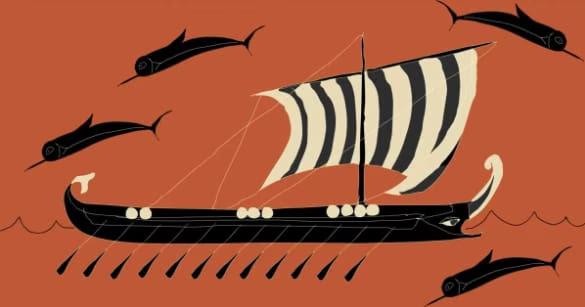A Solution to the Ship of Theseus

There's a thought experiment called The Ship of Theseus. It asks whether an object that's had all its components replaced still remains the same object.
The ship wherein Theseus and the youth of Athens returned from Crete had thirty oars, and was preserved by the Athenians down even to the time of Demetrius Phalereus, for they took away the old planks as they decayed, putting in new and stronger timber in their places, insomuch that this ship became a standing example among the philosophers, for the logical question of things that grow; one side holding that the ship remained the same, and the other contending that it was not the same.
Plutarch
So, if you replace an entire ship over time, bit by bit, with replacement parts that basically look and function identically, is it the same ship? The same question can be asked for a human body, since our cells are constantly dying and being replaced.
Because I think a lot about the nature of reality, and specifically meaning, I don't find this exercise that challenging.
To me, it comes down to the perspective of an observer to an object. If something doesn't change in a noticeable way based on your relationship to it, then it can be considered—by you—to be the same object. If it changes significantly—based on your perception—then it can be considered different.
One good example is the Big Dipper constellation, which is technically URSA Major. From our perspective on Earth, it looks like a ladle that you serve soup with. But that's only because we eat soup, and because we're in this particular location in space. And at this particular moment in time.
If we didn't eat soup for whatever reason, ladles wouldn't have any meaning. Or if we travelled to the other side of the galaxy, the Big Dipper wouldn't look like a dipper of any sort. Similarly, if we just stay on Earth but wait a while, all the stars will move and it'll no longer look anything like a ladle.
So, has the constellation changed? Is it still the Big Dipper in all those cases?
My answer is that it's not if the person who's assigning the label doesn't see it as such anymore. It comes down to their perception based on their relationship to the object. If they're forward or backward in time or space, or a few of the stars burn out, it might lose enough of its shape as to no longer be the real thing—at least to that person.
It's the same for the New York Yankees. For some people it was a baseball team from New York when they were growing up, and it still is. It's still the same team, even though the members of the team—and the managers—are all different. To others, they grew up watching a few key players, and once they left the team stopped being the Yankees.
It's the same for the ship. If you're an immortal bacteria living on a plank on the deck, you're slowly seeing parts of the ship get replaced, until one day you see all your friends get pried up and replaced by other planks. At that level of reality, your whole universe is different. And this is most definitely not the same ship.
But if you're a tree that lives for 5,000 years on a tropical island, and you have bad vision, then the Ship of Theseus visiting in 1901 will basically be the same ship when it returns in 1991, even if all the actual wood has been swapped with newer planks and beams.
So the answer to the question of, "Is it the same ship?" is simply this:
According to whom?
To some perspectives, it's a new ship every few nanoseconds. And to others, it'll be the same ship in 100 years—even if its wood is replaced with metal.
The perspective of the observer to the object is what matters, because that's what determines whether or not a given amount of change has a significant impact on the identity of the object—relative to that observer.
If the change isn't significant enough to the observer to call it something different, it's the same thing. If it's significant enough to be called something else, it's something else.
Names aren't reality; they're just handles that humans use to describe things.
So the riddle isn't about the ship at all. It's about the name of the ship—which is a human thing, not a ship thing.